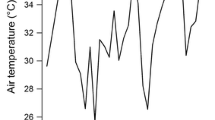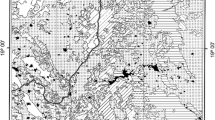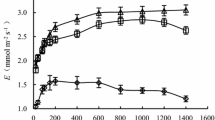Abstract
Drought stress is one of the most important factors in limiting the survival and growth of plants in the harsh karst habitats of southwestern China, especially at the seedling establishment stage. The ecophysiological response to drought stress of native plants with different growth forms is useful for re-vegetation programs. Two shrub and four tree species were studied, including Pyracantha fortuneana (evergreen shrub), Rosa cymosa (deciduous shrub), Cinnamomum bodinieri (evergreen tree), and other three deciduous trees, Broussonetia papyrifera, Platycarya longipes, and Pteroceltis tatarinowii. The seedlings were randomly assigned to four drought treatments, i.e., well-watered, mild drought stress, moderate drought stress, and severe drought stress. Leaf water relations, gas exchange, chlorophyll fluorescence, and growth of the seedlings were investigated. Under severe drought stress, the two shrubs with low leaf area ratio (LAR) maintained higher water status, higher photosynthetic capacity, and larger percent biomass increase than the most of the trees. The two shrubs also had lower specific leaf area, greater intrinsic water use efficiency, and thermal dissipation than the trees. This suggested that the two shrubs had high tolerance to severe drought and were suitable for re-vegetation in harsh habitats. The evergreen C. bodinieri exhibited higher leaf mass ratio (LMR) and LAR than the deciduous species under mild and moderate stress. However, the low maximum quantum efficiency of PSII photochemistry (F v/F m) and net assimilation rate, and the sharp decreases of water potential, LMR, LAR, and biomass under severe stress indicated C. bodinieri’s weak tolerance to severe drought. In response to drought stress, the three deciduous trees revealed sharp reductions of biomass due to the large drought-induced decreases of gas exchange, LAR, and LMR. Under drought conditions, the deciduous trees minimized water loss by stomatal closure and by reducing transpiration leaf area and light harvesting through shedding leaves. This suggested that the three deciduous trees were more sensitive to water availability than the shrubs and used avoidance strategies against drought stress. However, the better growth performance of the deciduous trees than that of the shrubs under favorable conditions suggested that deciduous trees could be suitable for habitats with mild and temporary drought stress.





Similar content being viewed by others
References
Anyia AO, Herzog H (2004) Water-use efficiency, leaf area and leaf gas exchange of cowpeas under mid-season drought. Eur J Agron 20:327–339
Bacelar EA, Moutinho-Pereira JM, Gonçalves BC, Ferreira HF, Correia CM (2007) Changes in growth, gas exchange, xylem hydraulic properties and water use efficiency of three olive cultivars under contrasting water availability regimes. Environ Exp Bot 60:183–192
Ceriani RM, Pierce S, Cerabolini B (2009) The survival strategy of the alpine endemic Primula glaucescens is fundamentally unchanged throughout its climate envelope despite superficial phenotypic variability. Plant Ecol 204:1–10
Chaves MM, Maroco JP, Pereira JS (2003) Understanding plant responses to drought—from genes to the whole plant. Funct Plant Biol 30:239–264
Chen JW, Zhang Q, Cao KF (2009) Inter-species variation of photosynthetic and xylem hydraulic traits in the deciduous and evergreen Euphorbiaceae tree species from a seasonally tropical forest in south-western China. Ecol Res 24:65–73
Dai XY, Cui YC, Wang J, Yao XH, Ren HD, Gong BC (2008) Investigation and analysis on the main tree species for the plantation in rock desertification areas in Guizhou Province. Guizhou For Sci Technol 36:35–39
Deng Y, Jiang ZC, Cao JH, Li Q, Lan FN (2004) Characteristics comparison of the leaf anatomy of Cyclobalanopsis glauca and its adaption to the environment of typical karst peak cluster areas in Nongla. Guihaia 24:317–322
Flexas J, Bota J, Escalona JM, Sampol B, Medrano H (2002) Effects of drought on photosynthesis in grapevines under field conditions: an evaluation of stomatal and mesophyll limitations. Funct Plant Biol 29:461–471
Flexas J, Bota J, Cifre J, Escalona JM, Galmés J, Gulías J, Lefi EK, Martínez-Cañellas SF, Moreno MT, Ribas-Carbó M, Riera D, Sampol B, Medrano H (2004a) Understanding down-regulation of photosynthesis under drought stress: future prospects and searching for physiological tools for irrigation management. Ann Appl Biol 144:273–283
Flexas J, Bota J, Loreto F, Cornic G, Sharkey TD (2004b) Diffusive and metabolic limitations to photosynthesis under drought and salinity in C3 plants. Plant Biol 6:269–279
Galmés J, Cifre J, Medrano H, Flexas J (2005) Modulation of relative growth rate and its components by drought stress in Mediterranean species with different growth forms. Oecologia 145:21–31
Gulías J, Flexas J, Mus M, Cifre J, Lefi E, Medrano H (2003) Relationship between maximum leaf photosynthesis, nitrogen content and specific leaf area in Balearic endemic and non-endemic Mediterranean species. Ann Bot 92:215–222
Huang YQ, Wang XY, Lu SH, Wang Q, Zhao P (2006) Studies of photosynthesis, transpiration and water use efficiency of some dominant species in rocky desert area, Guangxi, China. Guihaia 26:171–177
Lambers H, Chapin FS, Pons TL (1998) Plant physiological ecology. Springer-Verlag, New York
Li AD, Lu YF, Wei XL, Yu LF (2008) Studies on the regime of soil moisture under different microhabitats in Huajiang karst valley. Carsol Sin 27:56–62
Liu CQ (2009) Biogeochemical processes and cycling of nutrients in the earth’s surface: cycling of nutrients in soil–plant systems of karstic environments, Southwest China. Science Press, Beijing, China
Liu WL, Xie SX, Yu LF (2003) Physiological response of several karst common tree species seedlings to drought stress. Guizhou Sci 21:51–55
Liu CC, Wei YF, Liu YQ, Guo K (2009) Biomass of canopy and shrub layers of karst forests in Puding, Guizhou, China. Chin J Plant Ecol 33:698–705
Liu CC, Liu YG, Guo K, Zheng YR, Li GQ, Yu LF, Yang R (2010) Influence of drought intensity on the response of six woody karst species subjected to successive cycles of drought and rewatering. Physiol Plant 139:39–54
Maroco JP, Pereira JS, Chaves MM (2000) Growth, photosynthesis and water-use efficiency of two C4 Sahelian grasses subjected to water deficits. J Arid Environ 45:119–137
Maxwell K, Johnson GN (2000) Chlorophyll fluorescence—a practical guide. J Exp Bot 51:659–668
Mediavilla S, Escudero A (2004) Stomatal responses to drought of mature trees and seedlings of two co-occurring Mediterranean oaks. For Ecol Manage 187:281–294
Medrano H, Escalona JM, Bota J, Gulías J, Flexas J (2002) Regulation of photosynthesis of C3 plants in response to progressive drought: stomatal conductance as a reference parameter. Ann Bot 89:895–905
Medrano H, Flexas J, Galmés J (2009) Variability in water use efficiency at the leaf level among Mediterranean plants with different growth forms. Plant Soil 317:17–29
Moles AT, Westoby M (2004) What do seedlings die from and what are the implications for evolution of seed size? Oikos 106:193–199
Morgan JM (1984) Osmoregulation and drought stress in higher plants. Ann Rev Plant Physiol 35:299–319
Morse LJ, Day TA, Faeth SH (2002) Effect of Neotyphodium endophyte infection on growth and leaf gas exchange of Arizona fescue under contrasting water availability regimes. Environ Exp Bot 48:257–268
Reich PB, Walters MB, Ellsworth DS (1997) From tropics to tundra: global convergence in plant functioning. Proc Natl Acad Sci USA 94:13730–13734
Reich PB, Walters MB, Ellsworth DS, Vose JM, Volin JC, Gresham C, Bowman WD (1998) Relationships of leaf dark respiration to leaf nitrogen, specific leaf area and leaf life-span: a test across biomes and functional groups. Oecologia 114:471–482
Reich PB, Ellsworth DS, Walters MB, Vose JM, Gresham C, Volin JC, Bowman WD (1999) Generality of leaf trait relationships: a test across six biomes. Ecology 80:1955–1969
Rong L, Wang SJ, Liu N, Yang L (2005) Leaf anatomical characters and its ecological adaptation of the pioneer species in the karst mountain area—with a special reference to the Huajiang Canyon of Guizhou. J Mt Sci 23:35–42
Si B, Yao XH, Ren HD, Li S, He BH (2008) Species composition and diversity in the process of natural succession of karst vegetation in central Guizhou: a case study of Puding County in Guizhou. For Res 21:669–674
Siam AMJ, Radoglou KM, Noitsakis B, Smiris P (2009) Differences in ecophysiological responses to summer drought between seedlings of three deciduous oak species. For Ecol Manage 258:35–42
Turner NC (1986) Adaptation to drought stress deficits: a changing perspective. Aust J Plant Physiol 13:175–190
Valladares F, Sánchez-Gómez D (2006) Ecophysiological traits associated with drought in Mediterranean tree seedlings: individual responses versus interspecific trends in eleven species. Plant Biol 8:688–697
Wei XL, Xu XZ, Zhu SQ (2005) Variation of physiological and biochemical indexes in seedling of three Ulmaceae species under drought stress. J Nanjing For Univ 29:47–50
Wilson PJ, Thompson K, Hodgson JG (1999) Specific leaf area and leaf dry matter content as alternative predictors of plant strategies. New Phytol 143:155–162
Wu YY, Liu CQ, Li PP, Wang JZ, Xing D, Wang BL (2009) Photosynthetic characteristics involved in adaptability to Karst soil and alien invasion of paper mulberry (Broussonetia papyrifera (L.) Vent.) in comparison with mulberry (Morus alba L.). Photosynthetica 47:155–160
Zhang XS, Liu YH (2005) Study on the water consumption of main afforestation trees in Guizhou karst mountains regions. Guizhou For Sci Technol 33:25–40
Zhang JL, Zhu JJ, Cao KF (2007) Seasonal variation in photosynthesis in six woody species with different leaf phenology in a valley savanna in southwestern China. Trees Struct Funct 21:631–643
Zhu SQ (1997) Ecological research on karst forest (II). Guizhou Science and Technology Press, Guiyang, China
Zhu SQ (2003) Ecological research on karst forest (III). Guizhou Science and Technology Press, Guiyang, China
Zhu JJ, Zhang JL, Liu HC, Cao KF (2009) Photosynthesis, non-photochemical pathways and activities of antioxidant enzymes in a resilient evergreen oak under different climatic conditions from a valley-savanna in Southwest China. Physiol Plant 135:62–72
Acknowledgments
We thank the two anonymous reviewers for their helpful comments on our manuscript. We thank Prof. Xiaoli Wei and Mr. Changjin Li for their help during the experiment. We thank Dr. Yafen Wei and Dr. Jun Yang for their help in improving our English. This research was supported by the National Basic Research Program of China (973 Program No. 2006CB403206), the State Key Laboratory of Vegetation and Environmental Change of Institute of Botany, Chinese Academy of Sciences (No. 80006F2001), and the Knowledge Innovative Project of Chinese Academy of Sciences (No. kzcx2-yw-306).
Author information
Authors and Affiliations
Corresponding author
Additional information
Communicated by J. Major.
Rights and permissions
About this article
Cite this article
Liu, CC., Liu, YG., Guo, K. et al. Comparative ecophysiological responses to drought of two shrub and four tree species from karst habitats of southwestern China. Trees 25, 537–549 (2011). https://doi.org/10.1007/s00468-010-0533-7
Received:
Revised:
Accepted:
Published:
Issue Date:
DOI: https://doi.org/10.1007/s00468-010-0533-7




